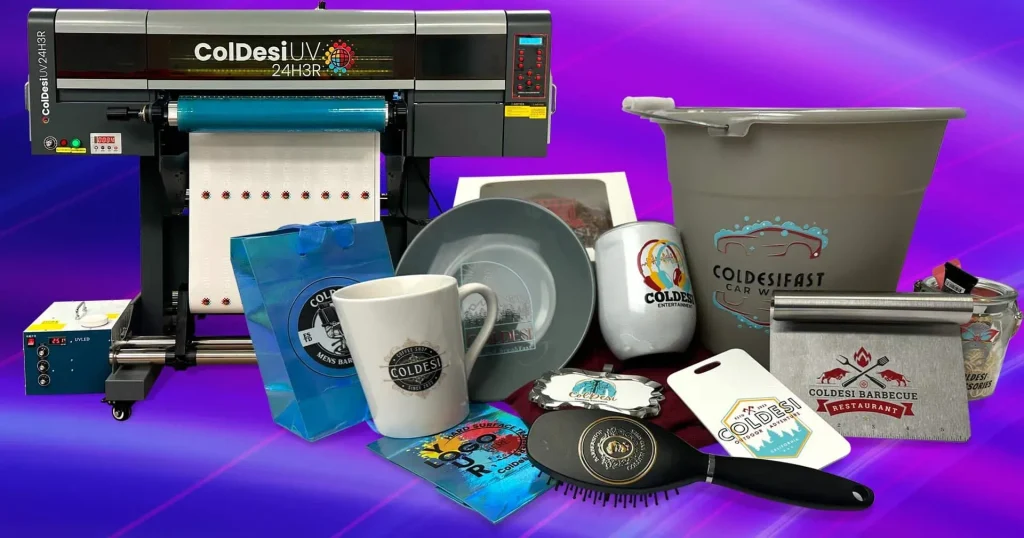UV DTF printing, or Direct to Film printing, is revolutionizing the realm of custom printing with its ability to produce stunning visuals on a variety of surfaces. This cutting-edge technology utilizes ultraviolet light to cure specialty inks, delivering vibrant and long-lasting prints that are perfect for everything from apparel to promotional products. As you venture into the world of UV DTF printing, it’s essential to familiarize yourself with key techniques, including effective UV DTF printing tips that can enhance your output quality. This beginner UV DTF guide is designed to demystify the process, providing you with insights on how to UV DTF print successfully and set up your workstation for optimal results. Whether you are aiming for intricate designs or simple logos, mastering UV DTF printing can elevate your creative projects and expand your business possibilities.
Known as Direct Film to UV printing, this innovative printing process has gained traction in recent years and is becoming a preferred choice for many creators. Using UV light, artists can transfer designs onto a wide range of materials, achieving remarkable durability and color depth. For those interested in diving into this printing technique, a well-structured beginner UV DTF guide can provide valuable insights into the necessary equipment, setups, and best practices. Learning how to effectively set up your workspace for UV DTF technology ensures that you can consistently produce high-quality prints. Exploring various UV DTF printing tips will not only enhance your results but will also enable you to navigate the intricacies of this fascinating technology more easily.
Understanding the Basics of UV DTF Printing
UV DTF printing, or Ultra Violet Direct to Film printing, is an advanced technology that employs ultraviolet light to cure the inks onto the film for subsequent transfer to various surfaces. This method not only guarantees durability but also offers vibrant colors that stand out beautifully. If you’re new to the process, it’s beneficial to familiarize yourself with the essential concepts that make UV DTF unique, particularly its color layering technique which involves applying a white base layer before adding colored inks. This process enhances the vividness of the prints, especially when working on darker materials.
As a beginner, understanding the technology behind UV DTF printing is fundamental to creating high-quality designs. The workflow typically begins with printing the white base, which acts as a canvas for colorful prints that follow. This layering technique ensures that the final product appears polished and visually appealing. By grasping these basics, you’ll be better prepared to tackle the more intricate aspects of UV DTF printing in your projects.
Frequently Asked Questions
What is UV DTF printing and how does it work?
UV DTF printing, or Ultraviolet Direct to Film printing, utilizes UV light to cure inks directly onto films that are then transferred to substrates. This process begins with a white base layer printed for vibrancy, followed by color printing to achieve sharp details and rich colors.
What equipment do I need for UV DTF printing?
Essential equipment for UV DTF printing includes a quality UV printer (brands like Epson and Roland are recommended), UV reactive inks suited for DTF applications, and a heat press with adjustable temperature and pressure settings to ensure optimal transfers.
What are some UV DTF printing tips for beginners?
Beginners in UV DTF printing should focus on thorough pre-press preparation, including cleaning surfaces and conducting test prints. It’s also crucial to maintain printer cleanliness and monitor ink levels to avoid interruptions during production.
How do I set up my printer for UV DTF printing?
To set up your printer for UV DTF printing, ensure that you’re using compatible UV inks, configure your printer settings according to the material, and perform test prints to adjust temperature and pressure settings accurately.
What are the maintenance practices for UV DTF printers?
Regular maintenance for UV DTF printers includes cleaning nozzles to prevent clogs, checking ink levels regularly, and establishing a cleaning schedule. This helps maintain print quality and extends the life of your printer.
Where can I find resources for learning UV DTF printing?
Resources for learning UV DTF printing include online forums like PrintWiki, YouTube tutorials for practical demonstrations, and industry blogs such as Printful and SGIA that cover the latest trends and technologies in UV DTF printing.
| Key Point | Details |
|---|---|
| Understanding UV DTF Technology | UV DTF printing utilizes UV light to cure inks on films for transfer to substrates, creating vibrant, durable prints. |
| Equipment and Setup | Invest in specialized UV printers, UV reactive inks, and quality heat presses. |
| Pre-Press Preparation | Clean surfaces and conduct test prints to ensure optimal settings before final printing. |
| Application Techniques | Perform test transfers and utilize transfer films to improve adhesion and durability. |
| Maintenance | Regular cleaning and monitoring ink levels are essential for consistent print quality. |
| Market Trends | Explore niche markets and consider partnerships to expand your reach. |
| Resources for Learning | Engage with online forums, YouTube tutorials, and industry blogs for ongoing education. |
Summary
UV DTF printing has established itself as a revolutionary technique in the world of printing technologies. Its ability to produce stunning, long-lasting prints on a variety of materials makes it an excellent choice for those venturing into custom apparel and personalized products. By understanding the operational nuances, choosing the right equipment, and maintaining your system properly, you can harness the full potential of UV DTF printing. This approach not only enhances the aesthetic quality of your products but also ensures that they stand the test of time. Stay engaged with community resources and trends to continuously improve your skills and adapt to market demands.



